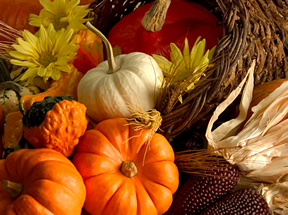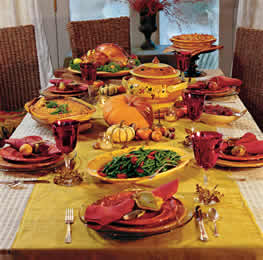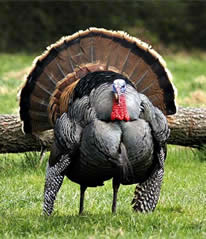What is Thanksgiving?
 Thanksgiving, or Thanksgiving Day, is a traditional North American holiday to give thanks at the conclusion of the harvest season. Thanksgiving is celebrated on the fourth Thursday of November in the United States and on the second Monday of October in Canada.
Thanksgiving, or Thanksgiving Day, is a traditional North American holiday to give thanks at the conclusion of the harvest season. Thanksgiving is celebrated on the fourth Thursday of November in the United States and on the second Monday of October in Canada.
In the United States, Thanksgiving is a four day weekend which usually marks a pause in school and college calendars. Families and friends gather for a reunion, a day of thanks, and a festive meal.
Thanksgiving meals are traditionally family events where certain kinds of food are served. First and foremost, turkey is the featured item in most Thanksgiving feasts (so much so that Thanksgiving is sometimes facetiously referred to as “Turkey Day”). Stuffing, mashed potatoes with gravy, sweet potatoes, cranberry sauce, corn, turnips, yams and pumpkin pie are commonly associated with Thanksgiving dinner. Often guests bring food items or help with cooking in the kitchen as part of a happy, communal meal.
In keeping with the holiday theme of giving thanks, during the socializing or meal, people talk about what they are thankful for or tell about experiences during the past year which have caused them to feel grateful.
The Pilgrims
The early settlers of Plymouth Colony in Massachusetts were particularly grateful to Squanto, the Native American and former British slave who taught them how to both catch eel and grow corn and also served as their native interpreter. Without Squanto’s assistance, the settlers might not have survived in the New World.
The Plymouth settlers (who came to be called “Pilgrims”) set apart a holiday immediately after their first harvest in 1621. They held an autumn celebration of food, feasting, and praising God. The Governor of Plymouth invited Grand Sachem Massasoit and the Wampanoag people to join them in the feast. Evidence to support that claim came from diaries of Plymouth. The settlers fed and entertained the Native Americans for three days, at which point some of the Native Americans went into the forest, killed 5 deer, and gave them to the Governor as a gift.
 The National Thanksgiving Proclamations
The National Thanksgiving Proclamations
National Thanksgiving Proclamations proclaim thanks for God’s providence in the events of the nation and, as President Washington explained in his Thanksgiving Proclamation, for the many signal favors of Almighty God in the lives of the people.
As congress recognized the importance of Thanksgiving observance, President George Washington issued a national Thanksgiving Proclamation in 1789. He wrote, “Now therefore I do recommend and assign Thursday the 26th day of November next to be devoted by the People of these States to the service of that great and glorious Being, who is the beneficent Author of all the good that was, that is, or that will be That we may then all unite in rendering unto him our sincere and humble thanks for his kind care and protection of the People of this Country…for the signal and manifold mercies, and the favorable interpositions of his Providence which we experienced in the tranquility, union, and plenty, which we have since enjoyed…and also that we may then unite in most humbly offering our prayers and supplications to the great Lord and Ruler of Nations and beseech him to pardon our national and other transgressions to enable us all, whether in public or private stations, to perform our several and relative duties properly and punctually…To promote the knowledge and practice of true religion and virtue, and the increase of science among them and us—and generally to grant unto all Mankind such a degree of temporal prosperity as he alone knows to be best.”
In 1789 Washington designated a national thanksgiving holiday for the newly ratified Constitution, specifically so that the people may thank God for “affording them an opportunity peaceably to establish a form of government for their safety and happiness” and for having “been enabled to establish constitutions of government for our safety and happiness, and particularly the national One now lately instituted, for the civil and religious liberty with which we are blessed… “
 The first official Thanksgiving Proclamation made in America was issued by the Continental Congress in 1777. Six national Proclamations of Thanksgiving were issued in the first thirty years after the founding of the United States of America as an independent federation of States. President George Washington issued two, President John Adams issued two, President Thomas Jefferson made none and President James Madison issued two. After 1815 there were no more Thanksgiving Proclamations until the Presidency of Lincoln, who made two during the Civil War.
The first official Thanksgiving Proclamation made in America was issued by the Continental Congress in 1777. Six national Proclamations of Thanksgiving were issued in the first thirty years after the founding of the United States of America as an independent federation of States. President George Washington issued two, President John Adams issued two, President Thomas Jefferson made none and President James Madison issued two. After 1815 there were no more Thanksgiving Proclamations until the Presidency of Lincoln, who made two during the Civil War.
President Lincoln declared Thanksgiving a Federal holiday as a “prayerful day of Thanksgiving” on the last Thursday in November. Since then every U.S. President has always made an official Thanksgiving Proclamation on behalf of the nation. President Franklin D. Roosevelt set the date for Thanksgiving to the fourth Thursday of November in 1939 (approved by Congress in 1941).
The centerpiece of contemporary Thanksgiving in the United States is a large meal, centered around a large roasted turkey. The majority of the dishes in the traditional American version of Thanksgiving Dinner are made from foods native to the New World, according to tradition the Pilgrims received these foods from the American Indians. However, many of the classic traditions attributed to the first Thanksgiving are actually myths introduced later.
Because turkey is the most common main dish of a Thanksgiving dinner, Thanksgiving is sometimes colloquially called Turkey Day (USA). The USDA estimated that 269 million turkeys were raised in the country in 2003, about one-sixth of which were destined for a Thanksgiving dinner plate.
Most Thanksgiving turkeys are stuffed with a cereal-based stuffing and roasted. Sage is the traditional herb added to the stuffing (also called dressing), along with chopped celery, carrots, and onions. Turducken, a turkey stuffed with a duck stuffed with a chicken, is becoming more popular, from its Cajun base in Louisiana. Deep-fried turkey is rising in popularity as well, requiring special fryers to hold the large bird, and reportedly leading to fires and bad burns for those who fail to take care when dealing with a large quantity of very hot oil. In more recent years it is also true that as the wild population of turkeys has rebounded in most of the US, some will hunt and dress their turkey in the woods and then freeze it until meal preparation.
The use of the turkey in the USA for Thanksgiving relates back to Lincoln’s nationalization of the holiday in 1863. Since a turkey could feed more than a chicken, those were sent to the troops instead as a more cost-effective feast. The most important detail of a thanksgiving dinner is the turkey.
Many other foods are served alongside the main dish so many that, because of the amount of food, the Thanksgiving meal is sometimes served midday or early afternoon to make time for all the eating, and preparation may begin at dawn or on days prior.
Traditional Thanksgiving foods are sometimes specific to the day, and although some of the foods might be seen at any semi-formal meal in the United States, the meal often has something of a ritual or traditional quality. Many Americans would say it’s “incomplete” without cranberry sauce, stuffing, and gravy. Other commonly served dishes include sweet potatoes, mashed potatoes, dumplings, corn on the cob, green beans or green bean casserole, peas and carrots, wheat flower bread rolls, and a Waldorf salad. For dessert, various pies are often served, particularly apple pie, mincemeat pie, sweet potato pie, pumpkin pie, and pecan pie, with the last three being particularly American.
Traditional Thanksgiving meal in New England
There are also regional differences as to the stuffing (or “dressing”) traditionally served with the turkey. Southerners generally make theirs from cornbread, while in other parts of the country white or wheat bread is the base. One or several of the following may be added: oysters, apples, chestnuts, raisins, celery and/or other vegetables, sausages or the turkey’s giblets. The traditional Canadian version has bread cubes, sage, onion and celery. Rice is also sometimes used instead of bread in Canada.
Other dishes reflect the region or cultural background of those who have come together for the meal. For example, many African Americans and Southerners serve baked macaroni and cheese and collard greens, while Italian-Americans often have lasagna on the table and Ashkenazi Jews may serve noodle kugel, a sweet dessert pudding. It is not unheard of for Mexican Americans to serve their turkey with mole and roasted corn. Vegetarians or vegans have been known to serve alternative entree centerpieces such as a large vegetable pie or a stuffed and baked pumpkin or tofurkey.
While the turkey stemmed in the USA from Civil Wartime cost effectiveness, side dishes came soon after. The sweet potato was added to the “Traditional dinner” to let Southerners feel welcome into the activity, while cranberry sauce was for alienated Northeasterners.




